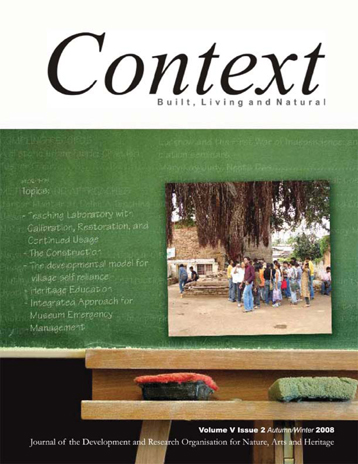Volume V Issue 2
About the volume
Heritage awareness and education is probably the key to long-term sustenance of our cultural heritage. Conservation remains a challenge in a country like India, where masses continue to struggle with day to day needs of food and infrastructure, cultural beliefs advocate constant renewal of sites and development is associated with new materials and technology. The solution lies in instigating a deeper understanding of the use and significance of this heritage amongst the people, supplemented with a parallel comprehension of the ground realities by the professionals in the field.
The issue brings forth few such examples that present interesting approaches towards an understanding of history and heritage. The documentation and analysis of transformations of Kucha Ghasi Ram depict the impact of urban growth and changing society on the built fabric. On the theme of the First War of Independence of 1857, the two articles on Delhi and Lucknow showcase two different perspectives. While ‘Mutiny Myth Making’ addresses glorification of the British who participated in the war and the creation of a social and physical phenomenon, ‘Lucknow, the First War of Independence’ studies the impact of the war on the built fabric and explores means to document and interpret the same today.
The Jantar Mantar experience provides an innovative reuse of our astronomical heritage that complements the restoration works undertaken for the site. The case of Jogeshwari caves in Mumbai enumerates the existing social conflict with practiced conservation guidelines, a situation faced in hundreds of similar sites across the country. ‘Museum Emergency Management’ calls for an integrated approach, addressing new avenues for our cultural heritage sites in the wake of recent events and catastrophes.
Sustainable solutions section covers both the urban and the rural landscape. The design of Naya Raipur as a new capital city aims to integrate environmental and social aspects in planning while the success story of a village panchayat at Odanthurai presents the use of latest technology to create a self reliant responsive administration.
We continue to provide analytical articles on urban development works under the JNNURM section. This issue features an assessment of the ground reality vis-a-vis the objectives of the JNNURM mission for the city of Chennai. ‘Engendered Perspectives’ highlights the need for and lack of gender sensitivity in the objectives under this mission.
For heritage to play a meaningful role in the present context and the future, generating awareness amongst children is essential, an aspect that is covered under the collective book review.
Shikha Jain
Contents
About the volume
Compiling Records
Kucha Ghasi Ram: A heritage street
Somya Johri
Methods and Approaches
Mutiny Myth Making: The construction of John Nicholson as the ‘Hero of Delhi’
Jyoti P Sharma
Lucknow, the First War of Independence: An exploration through conservation appreciation seminars
Mary Kay Judy and Neeta Das
Community Open Spaces: Evolving a user friendly landscape
Abhijit Natu
Museum Emergency Management: An integrated approach
Rohit Jigyasu
Jantar Mantar, Delhi: A teaching laboratory with continued use
N Rathnasree
The Heritage-Slum Relationship in Mumbai: Coexistence and conflict
Sheela Patel and Malvika Agarwal
Sustainable Solutions
Naya Raipur, Chhattisgarh: A sustainable urban design perspective
Sudeshna Chatterjee
Odanthurai Experience: A developmental model for village self-reliance
R Shanmugam
JNNURM Section
Status of JNNURM in Chennai
G Dattatri
Engendered Perspectives: An analysis of the JNNURM
Kanak Tiwari and Julie Thekkudan
Book Review
Rediscovering Heritage, the fun way Anshu Meshack
Events and Conferences
Heritage AlbumKarnataka Heritage: Aihole, Badami, Bijapur and Pattadakal
Poonam Verma Mascarenhas

